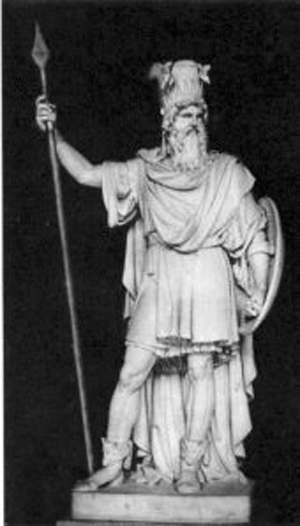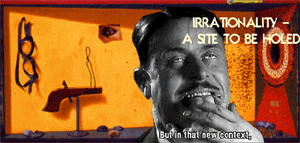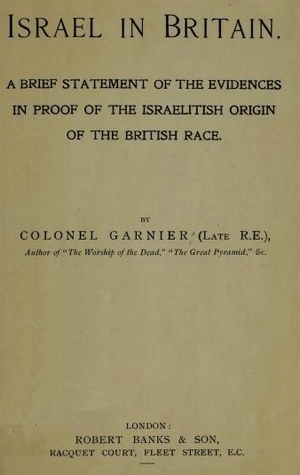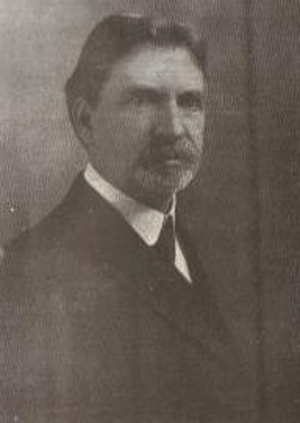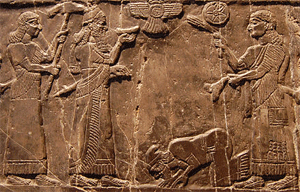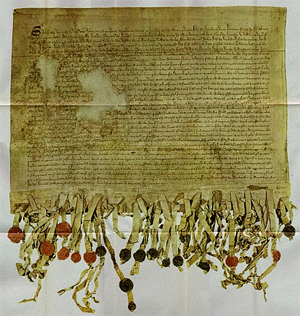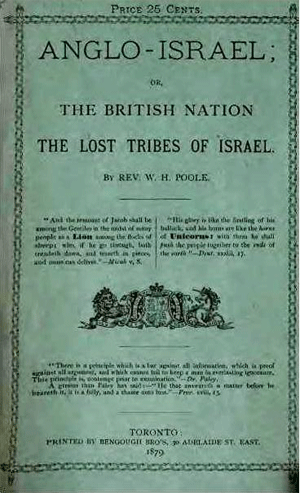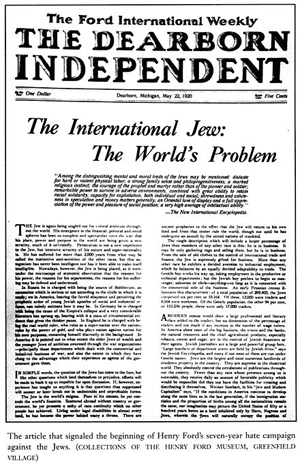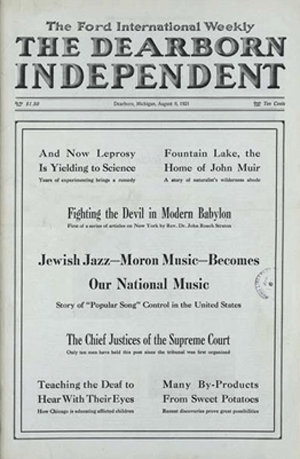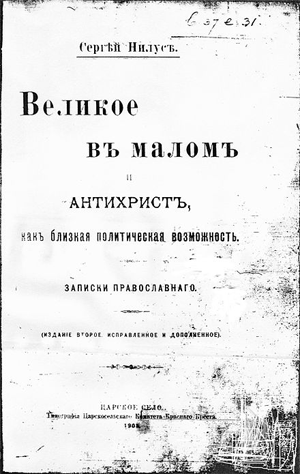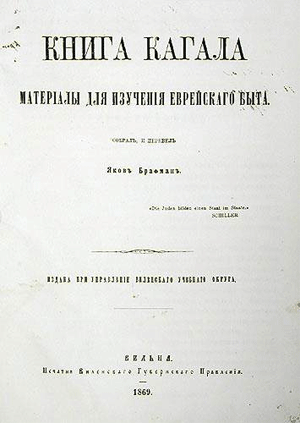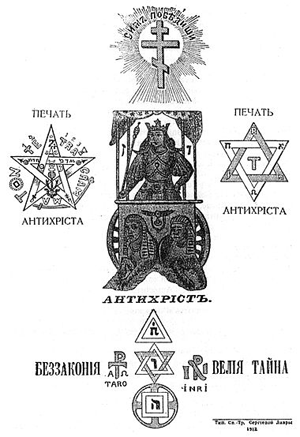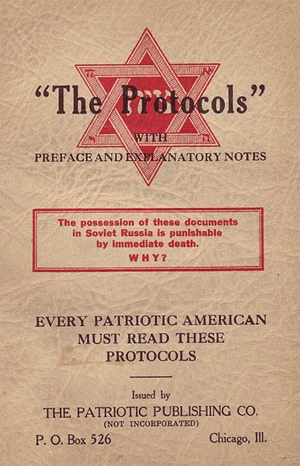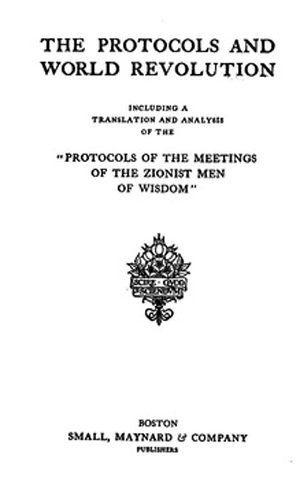The Rise of the Nazi Dictatorship and its Relationship with the Mormon Church in Germany, 1933-1939
by Steve Carter
International Journal of Mormon Studies, Volume 3
Spring 2010
©2010 International Journal of Mormon Studies
NOTICE: THIS WORK MAY BE PROTECTED BY COPYRIGHT
YOU ARE REQUIRED TO READ THE COPYRIGHT NOTICE AT THIS LINK BEFORE YOU READ THE FOLLOWING WORK, THAT IS AVAILABLE SOLELY FOR PRIVATE STUDY, SCHOLARSHIP OR RESEARCH PURSUANT TO 17 U.S.C. SECTION 107 AND 108. IN THE EVENT THAT THE LIBRARY DETERMINES THAT UNLAWFUL COPYING OF THIS WORK HAS OCCURRED, THE LIBRARY HAS THE RIGHT TO BLOCK THE I.P. ADDRESS AT WHICH THE UNLAWFUL COPYING APPEARED TO HAVE OCCURRED. THANK YOU FOR RESPECTING THE RIGHTS OF COPYRIGHT OWNERS.
On 30 January 1933, Adolf Hitler and the National Socialist party came to power and began to establish a dictatorship in Germany. It was the Nazis' intent to control all facets of life in the Third Reich including the institutional church. The relationship between the regime and the German religious community is complex and controversial. Although Hitler early on assured the churches that Christianity was welcomed in the Reich, [1] the Nazis soon launched a campaign against it. Through a concordat, the German dictator was able to neutralize the Catholic Church. And, aided by the pro-Nazi "German Christians," Hitler went a long way in coordinating the Evangelical Church with party aims. Nazi policy toward the smaller Christian denominations was ad hoc. The Nazis sought to control [2] and eventually eliminate these religious bodies, yet generally tolerated the ones deemed beneficial to party aims. [3] Eventually, many small, non-traditional religions [4] were banned, while the "Free Churches," primarily Baptists and Methodists, were allowed to function because Hitler thought they could be useful to his purposes. [5]
The relationship between the Church of Jesus Christ of Latter-day Saints and the Nazi regime was also complex. At no time during the 1930s was the Mormon Church banned in the Reich; however, it was not completely welcomed either. To be sure, Mormons were affected by Nazi anti-religious policies. This paper will review and analyze the relationship and interaction between the LDS Church and the Third Reich. I argue that Nazi harassment of the Mormons was sporadic and based primarily on the whims of local party officials rather than any formalized national policy. In the end, the Nazi course of action regarding the Latter-day Saints was similar to the regime's policy toward the Free Churches; the Party tolerated Mormons because it believed the LDS could be useful.
The Rise of Hitler and the Formulation of LDS Policy
Prior to World War I the spread of Mormonism in Germany had been slow. During the 1920s, however, the denomination enjoyed impressive growth throughout the country. In 1930 Mormonism claimed over 12,000 followers in Germany; by 1938 this number had passed 13,000. [6] This represented the largest pocket of Latter-day Saints outside the United States. Because of such success, Mormon leaders in the USA were optimistic about the Church in Germany well into the 1930s. [7]
By the middle of 1933, the Nazi regime had busied itself consolidating power in Germany including implementing its policies toward the Catholics and Protestants. At this point, the Nazis began to investigate the smaller denominations including the Mormons. [8]
That summer, both LDS mission presidents— Francis Salzner of the Swiss-German mission and Oliver Budge of the German-Austrian mission— were confronted by Nazi authorities and asked to issue concise written statements regarding Mormon attitudes toward the Hitler regime. [9] Although Church leaders in Utah had advised the mission presidents to "get along" with government officials, they did not provide specifics on how to proceed. [10] As a result, Salzner and Budge, in written statements, had the unenviable task of formulating Church policy with regard to the German state. Their responses to the Nazi inquiries, which became the basis of Mormon policy toward the Third Reich, were nearly identical and will be examined together.
The essence of the mission presidents' statements was to affirm the Church's spiritual mission. Salzner and Budge emphasized that, although Mormons considered themselves "apolitical," the Church taught its followers to be good and law-abiding citizens and to support the "powers that be" in accordance to the Church's Twelfth Article of Faith. [11] They stressed the Mormon belief in religious toleration [12] and asserted that the Church would not attack other denominations including the German Christians. Furthermore, the statements suggested that the Church's lay ministry and self-supporting missionary program brought foreign currency into Germany. [13] Finally, the mission presidents addressed values such as the family that were shared by both parties. [14]
As of 2002, Mormons "constituted 63% of Utah's population ... Virtually all statewide elective offices, from the governor down, are held by Saints ... the state legislature is overwhelmingly made up of white Mormon Republican males. Three fourths of the state judiciary is Mormon. The entire United States Congressional delegation from Utah is Mormon. School boards, city councils, municipal agencies, and mayors offices are dominated by Mormons." The editor of the Salt Lake Tribune summed it up thus: "The fact is, we live in a quasi-theocracy. 80% of officeholders are of a single party, 90% of a single religion, 99% of a single race, and 85% of one gender." (Lawrence Wright, "Lives of the Saints: at a Time When Mormonism is Booming, the Church is Struggling with a Troubled Legacy," New Yorker, January 21, 2002.) The constitutionally mandated separation of church and state is much neglected in Utah. The majority of public junior high schools and high schools have an in-house Mormon seminary which serves for religious studies. This is the Mormon tradition, and it is therefore difficult to imagine that a Romney cabinet would look like America. It might well look more like Utah, where Salt Lake City may well be the most lily-white city on the planet.
-- Just Too Weird: Bishop Romney and the Mormon Takeover of America: Polygamy, Theocracy, and Subversion, by Webster Griffin Tarpley, Ph.D.
There were three goals the mission presidents sought to achieve. First, they wanted to "get along" with the Nazi regime and avoid confrontations that could place the Mormon community in peril. Second, they sought to maintain the Church and its "gains" in Germany. Finally, mission leaders hoped to continue spreading the spiritual message of Mormonism through missionary activity. [15] The German mission leaders' policy was congruent with the prevailing Church accommodation policy toward secular government and the Twelfth Article of Faith established in 1890.
Apparently, the mission presidents' statements satisfied Nazi authorities. There are no immediate reports of harassment of any kind. Commenting on conditions in Germany, the 21 October 1933 issue of the Salt Lake City Deseret News, Church Section, reported, "The German-Austrian mission has been left almost untouched by the revolution in Germany." [16]
Harassment of the Mormons
Although Mormons escaped the initial persecution suffered by other denominations, they did not go unnoticed by Nazi authorities. As Hitler tightened his grip, the Gestapo kept vigil on all religious groups, [17] including the Mormons. On occasion, Gestapo agents monitored LDS worship services, [18] interrogated branch and district presidents, or confiscated branch records. [19] Some requested a list of names of branch members accompanied by their political party affiliation. [20] In their effort to "get along," LDS leaders complied with these demands. [21]
A real concern for branch presidents, though, was that a member might say something that Gestapo agents would consider subversive. Local leaders and American missionaries cautioned their congregations about such dangers and reminded them to follow the Twelfth Article of Faith. [22] Because of these measures, the secret police was unable to detect anything "subversive" about Latter-day Saint meetings. [23]
Elimination of the LDS Scouting Organization
On the national level, Mormons did not experience any pressure from the regime until 1934. In 1933, Hitler had begun the process of dissolving youth organizations or incorporating them into the Hitler Youth including the Boy Scouts. [24] In early March 1934, Nazi authorities notified Mormon officials to incorporate the LDS Scouting program [25] into the Hitler Youth or to disband. For several weeks, Mormon youth leaders corresponded with government officials pleading their case for maintaining the program. [26] Throughout the correspondence, Mormon Scouts continued to function and carry out their activities. [27] Finally, under duress, and desiring to "remain in harmony with" the Nazi regime, the Mormons acquiesced and dissolved its Scouting program on 30 April 1934. [28]
The dissolution of the Scouting program sheds light on Mormon policy toward the Nazi regime. By abandoning the Scouts, the Mormons indicated their willingness to oblige the Nazis. Still, they haggled with the regime and then dissolved their troops rather than incorporate them into the Hitler Youth. The Mormons chose to accept their fate, [29] but in such a way as to avoid direct Party control over their youth.
There were also cases where Mormons were affected by the general prohibitions placed on all religions by the Nazi regime. In 1934, the National Socialists issued a decree that no denomination could use Hebrew words such as "Israel", "Sabbath", "Zion"— words common in Mormon usage. [30] In keeping with the spirit of accommodation, Mormons throughout Germany complied with this decree. [31] The decree also led government officials to ban the book, The Articles of Faith by James E. Talmage, because of its references to "Zion" and "Israel." [32] The Nazis also banned Church tracts, including "Gottliche Vollmacht" ("Divine Authority") and "Signs of the Great Apostasy" which, Party activists claimed, constituted an affront to their own power in Germany. [33]
Nazi officials were also concerned that foreign-based religions might drain the Reich of much-needed currency. [34] This concern led German authorities to monitor LDS financial activities, insist that LDS tithes remain in Germany, and confiscate donation records from branches. [35] In October 1934, as part of Finance Minister Hjalmar Schacht's new economic plan to control foreign exchange, [36] the government withdrew from the LDS missionaries the privilege of purchasing valuable "Registered Marks." [37] Although Mormons were not the primary target of this plan, German officials charged that the missionaries were not paying their own way. Schacht's policy had a profound impact on the Church forcing the missions to curtail many of their activities. [38] In response, the mission presidents [39] in Europe and the First Presidency in Utah worked through the U.S. State Department, the American diplomatic corps, and the American Express Company to resolve this crisis. In March, 1936, the regime let up and restored to the missionaries the privilege of remitting Registered Marks. [40]
The Nazi "Let Up" on the Mormons and the Illusion of "Good Relations"
Between 1934 and 1936, most religious denominations suffered increased persecution at the hands of the Nazis. Both Catholic and Protestant clergymen encountered Nazi harassment and imprisonment. The Nazis also proceeded viciously against the smaller denominations. By contrast, harassment of the Mormons suddenly subsided in mid-1934 as noted by both Mormon and American government officials. In July, Francis Salzner, was questioned about Mormon views of the regime to which he reaffirmed the LDS accommodation policy and positive attitudes toward secular government. After the meeting, a surprised Salzner reported that the Gestapo agent confided to him that the Mormons had nothing to fear from the Nazis. [41] On 31 July, Utah Senator Elbert Thomas met with American Ambassador William Dodd in Berlin to discuss issues relating to Mormon missionaries in Germany. After the meeting, Dodd noted in his diary, "There are a number of Mormons in Germany and Hitler has not dissolved their organizations or expelled their active preachers. There are other than religious aspects to Hitler's let-up on the Mormons." [42]
Some historians have suggested a collaborationist relationship between Mormons and the Nazis based on a conjunction of worldviews including similar beliefs, doctrines and practices. Moreover, they argue that Mormons tried to convey this view to Nazi officials in order to escape persecution. [43]
Historian Douglas Tobler counters this thesis by arguing it was actually a disjunction of worldviews which formed the "foundation of the Nazi-Mormon relationship." According to Tobler, although there was some agreement of peripheral principles, the Nazis were concerned with gaining a "monopoly of power" and considered sectarian theology nonsense. On the other hand, Mormons were interested in their spiritual mission, not political power. [44] Mission documents further bolster this argument. In 1935, for example, mission records indicate "that the German attitude toward the [Mormon] Church, or any church, was that the churches were for the 'soul saving' part of life only, and that the state should develop the youth, and that the churches should not interfere in state affairs." [45]
The Nazis, in other words, found little in Mormonism they considered subversive. The regime seems to have regarded Mormons as "apolitical" and patriotic citizens. They may also have accepted some Mormon beliefs and practices as compatible with their own values. Tobler maintains that "presumably, the Nazis found no specific doctrines like rejection of military service, occultism or total reliance upon God's power in healing the sick" that would cause them concern. [46] Hitler's regime was thus willing to tolerate Mormons while it continued to consolidate power. In many respects, the Nazis' attitude toward the Latter-day Saints resembled their views of the Free churches who desired to retain independence to preach the gospel. [47] The Free Churches advocated separation of church and state, supported themselves financially and had relatively insignificant membership in Germany. Furthermore, many of these denominations had some influence abroad. Therefore, the Nazis, in the interests of foreign relations refrained from blatant harassment of these denominations. [48]
Official tolerance of the Mormons, however, turned out to be a mirage. Douglas Tobler and Alan Keele have described this two-year illusion of harmonious relations as a "fool's paradise." [49] Mormons continued their policy of accommodation with the Nazis, though the regime appears to have paid little attention to them except within the context of an overall policy on religion. [50] Each side was willing to ignore the other as long as it was left alone. As Tobler and Keele assert, "[ b]eing largely oblivious to the thrust of the numerous major events and policy changes going on at the time, Mormons tended to evaluate their circumstances largely in isolation on the basis of their personal well-being and the condition of the Church." [51] Nevertheless, both sides took advantage of opportunities presented by the other to advance their goals.
Doctrinal Parallels and Compatibility
That said, it cannot be denied that Mormons and Nazis did by coincidence rather than design share some common doctrinal ground, and both were aware of the similarities. [52] And it was the parallels that reinforced the illusion held by German Mormons. [53]
Among views shared by the two parties were an emphasis on genealogical research, the family, and the importance of health. Many Mormons also viewed several Nazi programs as resembling their own such as one of Hitler's program known as Eintopf Sonntag or "stew Sundays," in which participants fixed a modest meal and donated what they saved to the Nazi welfare program; a practice similar to the traditional Mormon "Fast Sunday."
Although superficially similar, the goals and objectives of the Mormons and Nazis were quite different. [54] Mormon programs reflected the faith's spiritual mission, while those of the Nazis represented their obsession for political and racial domination. Even so, common attitudes made Nazism more palatable to Mormons and Mormonism less suspect to Hitler's minions. [55]
Contacts with the Government
On 1 August 1934, Roy Welker became president of the German-Austrian mission; his tenure as mission president contributed to the illusion of "good feelings." Before leaving for Berlin, Welker met with President Heber J. Grant to discuss the German situation. Grant simply instructed Welker verbally to "meet the situation as it was," and to "exercise [his] own wisdom." [56] These vague directions left Welker on his own to deal with the Nazi regime. [57] Throughout his presidency, Welker continued the accommodation policy by complying with Nazi requests and investigations [58] which he later asserted was the "best policy." [59]
Welker also sought contacts with government officials. In 1936, he sent copies of Mormon scriptures to government officials including Adolf Hitler himself. [60] Furthermore, Welker met a low-ranking official from the Ministry of Religion who assured the mission president that the Mormons were in no danger. [61] Welker's wife, Elizabeth, also cultivated ties with the regime by occasionally meeting and establishing a working friendship with Gertrude Scholtz-Klink, head of the Nazi women's auxiliary, the NS Frauenschaft. [62]
Although both Welkers believed that their efforts improved the status of the Mormon Church in Germany, there is little evidence to bolster their claims. As Tobler concludes, "Welker apparently was convinced that '...Hitler was very much impressed with the Mormons,' a statement lacking support from other evidence." [63]
Harassment of LDS at the Local Level
While governmental pressure on the Latter-day Saints at the national level subsided considerably during 1934, at the local level harassment became quite intense. [64] In their 1933 year-end reports to Salt Lake City, both Francis Salzner and Oliver Budge wrote that the Reich government had interfered little with the activities of the Church. [65] However, Budge also indicated that zealous party members had harassed both the members and the missionaries; a point alluded to by Salzner. [66] Mission records from 1933 on indicate that local Nazi officials, aided by Catholic and Protestant clergymen, led attacks against Mormons. [67]
The Mormons were not persecuted in Nazi Germany. They felt the hot lash of Nazi disfavor only to the extent that other, ordinary Germans may have experienced harassment if they attracted attention or consorted with foreigners. The incidents described in Table 6 could have occurred in any secular or spiritual realm during the Third Reich. Considering the perceived divine nature of the Mormons’ undertaking and their history of being persecuted, an occasional, nonlethal squabble with the Nazi state was a small price to pay in order to reap God’s eventual glory. In the nineteenth century, because of the specter of polygamy, universal opposition by clerics, and hostility regarding the emigration of marriageable young women and draft-age men, Mormons seemed distinctly out of place in Germany. Weimar democracy gave constitutional rights to both the Mormons and their clerical antagonists, and the Mormons gained a grudging acceptance of their right to coexist in the shadow of the Catholics and Protestants. Under Nazi rule, when ecclesiastical opposition faded, Mormons finally became the kind of ordinary Germans that historian Eric Johnson described:Most Germans . . . slept soundly at night, worked productively by day and enjoyed their lives during the peacetime years of National Socialist rule. Why should they not have? The economy was improving, most were finding employment, and their country was regaining its pride and was still at peace. . . . They knew there was a strong police presence, a surfeit of laws placing limitations on personal freedom, and potential danger for those who refused to comply with Hitler’s wishes. Many grumbled and complained privately, but most found little difficulty in conforming. . . . Nazi terror posed no real threat to most ordinary Germans.51
-- The Mormons in Nazi Germany: History and Memory, by David Conley Nelson
Nazi persecution on the local level took one of two forms. The first was the harassment of missionaries. In many localities the police limited missionary proselyting activities such as prohibiting going door to door or banning "cottage meetings." [68] Occasionally, police arrested missionaries and searched their apartments for subversive items. Throughout Germany, party officials banned missionaries from their cities. In extreme cases, local brown shirts used physical violence against the missionaries. For example, in April 1933, missionaries in Hindenburg were attacked by a uniformed Nazi who beat them with his belt. Party members also nearly beat Reed Bradford to death for refusal to salute a Nazi flag. [69]
In April 1933 a “uniformed Nazi” assaulted two American Mormon missionaries, P. Blair Ellsworth and Preston C. Allen, while the pair was walking door-to-door, seeking converts in the small town of Hindenburg, located in the Stendal district of northern Germany. The assailant, either an SA “storm trooper” or an older member of the Hitler Youth, removed his belt and began hitting Elder Ellsworth with the buckle end. The attack severely lacerated Ellsworth’s scalp. When the perpetrator and his two victims arrived at the police station, and later when they appeared in court, the Mormon missionaries declined to press charges. After consultation with their mission president, they decided it was “better not to arouse trouble.” The magistrate ordered the Nazi thug to apologize. He refused but received no penalty for either the assault or for violating the court’s order. [1]
This incident marks the only instance recorded in official Mormon mission records of an unprovoked, physical attack on representatives of the LDS Church by anyone connected with the National Socialist government or Nazi Party auxiliary organizations.2 The belt-whipping assault, which appears in the writings of faith-promoting author Gilbert Scharffs and Henderson State University historian Steven Carter, has become part of the lore that involves the Mormons in Nazi Germany.3 Together with the celebrated case of resister Helmuth Hübener and a few other incidents that occurred during wartime, it buttresses the myth that the Mormons were persecuted in Nazi Germany. Quite to the contrary, the Mormon survival strategy of accommodation and ingratiation made life as Latter-day Saints in Nazi Germany as tolerable as it was for other Christians who owed allegiances to both a church and the state.
_______________
Notes:
1 German-Austrian Mission Manuscript Histories, 3 Apr. 1933; German-Austrian Mission Quarterly Reports, Dec. 1933 (year-end report).
2 Carter, “Mormons in the Third Reich,” 73. Steven Carter, using an unpublished paper authored by Brigham Young University’s Douglas Tobler, cites an undated incident that did not appear in the official records of the two Mormon missions, a reference to a missionary named Reed Bradford whom “Party members . . . nearly beat to death for refusal to salute the Nazi flag.” The citation also does not reveal the location of that attack.
3 Scharffs, Mormonism in Germany, 84; Carter, “Mormons in the Third Reich,” 73. With regard to the belt whipping of missionaries Ellsworth and Allen, Scharffs’ account differs from the contents of the German-Austrian Mission Manuscript Histories and Quarterly Reports. Scharffs said: “Police refused to do anything about it.” The records show that the victims and the assailant appeared before a judge or a magistrate, and that the Mormons declined to press charges.
-- The Mormons in Nazi Germany: History and Memory, by David Conley Nelson
The second technique used by local authorities was to attack the native branches. Agents interrogated local members, confiscated branch records, and disrupted worship services. [70] Usually, members met with the police, explained Mormon activities and the quoted the Twelfth Article of Faith. Most of the time they convinced party officials that their "intentions were in harmony with those of the government" and not subversive. [71] In extreme cases based on "political suspicion," police closed the meeting halls [72] used by Mormons forcing the closure of several branches. [73]
Local harassment of Mormons varied from place to place, and from official to official. In Karlsruhe, Mormons were treated well. [74] On the other hand, branches in Breslau, Dresden and Hamburg suffered intense harassment. In 1935, missionaries were banned in Saxony. [75] This pattern of uneven treatment suggests that local Nazi leaders, not the Reich government, determined policy regarding Mormons.
The 1936 Berlin Olympics
Local harassment did have an effect on missionary proselyting activities. By mid-1935, mission documents state "tracting averages for the missionaries have reached a low point. Plans are being worked out to find a way in which this important missionary activity, in spite of police restrictions, can be increased." [76] Missionaries in both missions turned to unorthodox methods to contact potential converts. In particular, the American missionaries turned to basketball, [77] which President Welker endorsed. [78]
It is impossible to determine the impact of "basketball proselyting" although some missionaries were able to develop a good rapport with the local officials at a time of intense local harassment. [79] One unexpected outcome occurred in 1935 when the German army recruited several missionaries to teach basketball to the soldiers. [80] Later, officials asked several missionaries to train the German Olympic basketball team and help officiate during the 1936 Berlin Olympic Games. [81] Mormons saw this representing recognition by national leaders and as a way to improve the religion's status. The Nazis believed that Mormon missionaries could help them in their propaganda effort by achieving a victory for the German basketball team. [82] In the end, however, the German Olympic basketball team exited the tournament early. And although Mormons were involved in such a high profile event, there is no evidence the Olympics improved their image or respectability. [83]
The Olympics, however, did benefit Mormons indirectly as the Hitler dictatorship put forth its best appearance and temporarily relaxed its attacks on religion. [84] Under these conditions, Mormons held their largest youth conference before World War II in Berlin, and missionaries found it easier to proselytize at this time. Mission records from October, 1936, noted "[t]racting and visiting totals continue to show increased activity on the part of the missionaries." [85]
Renewed Harassment
The Olympics represented the climax of a two-year period of seemingly cordial relations between the Mormons and the Nazi regime. Shortly after the Olympics, however, the Nazis renewed their assault on the Christian churches. [86]
Mormons also experienced an intensification of harassment. In Hamburg, Nazis charged district president, Alwin Brey, with spying for the United States. [87] For months, government authorities monitored LDS congregations and missionaries, censored their correspondence, and confiscated records and publications. Moreover, officials informed Brey "[I]f the Church wished to remain in [Hamburg] they must cease all youth activities and gathering." Brey complied with this demand and canceled a proposed "Youth Day." The impact upon the LDS community in Hamburg was chilling. Church reports noted, "[a] decided tension between the government's attitude in this district was everywhere apparent." [88] Similar harassment and "investigations" occurred throughout the Reich. [89]
Many missionaries felt the sting of renewed Nazi persecution. In addition to the usual harassment, a number of missionaries were arrested as suspected American spies and incarcerated for several days. [90] There were incidents of anti-Mormons who denounced the missionaries as representatives of a banned sect. The missionaries would have to prove, through intense interrogations, that this was not the case. [91]
There was always a concern among Mormon leaders that young callow missionaries might do or say something to endanger the Church, [92] and during the late 1930s there were two incidents in which missionaries did offend Nazi sensibilities. In 1937, Alvin Schoenhals was arrested after the Nazis intercepted a letter he wrote criticizing the regime. After a month in jail, Schoenhals was deported. [93] Later, a set of missionaries had to flee to Switzerland after the Gestapo obtained a photo of the two with a party flag wrapped around themselves like a breech cloth. [94]
Mormon leaders in both Germany and Utah took these incidents seriously. During the summer of 1939, the Church sent Apostle Joseph Fielding Smith to Germany in part to investigate these events. [95] Such incidents, no doubt, contributed to the Nazis' growing suspicion of the Mormons. A 1935 Gestapo report on "subversive activities" of religious organizations omitted mention of the Latter-day Saints. [96] Three years later, the Security Service (SD) labeled Mormons "enemies of the state." [97] By late 1937 and early 1938, however, as Hitler was preparing for war and needed national support, the overall church struggle in Germany subsided. [98] This, in part, prevented the Nazis from attacking the Mormons more vigorously. At the same time, not wanting to antagonize the United States unnecessarily, especially while high LDS dignitaries from Utah, including J. Reuben Clark and church president Heber J. Grant, were touring Germany, the Hitler regime "did not look at [the Mormons] as a very serious problem." [99]
The Mormons and the German Media
One of the more controversial events concerning the relations between Mormons and the regime centered on the Church and the media. Ever since the founding of Mormonism, Latter-day Saints faced unflattering accounts in the media at home and abroad. During the Nazi era, however, they experienced both positive and negative media coverage. [100]
Mormons, too, appreciated the media and utilized it in Europe to spread their message. [101] Moreover, LDS leaders sought opportunities to rebut false accounts of Mormonism in local newspapers. [102] It was this activity that led to the appearance of a controversial article in the Volkischer Beobachter in the spring of 1939.
In November, 1938, the Nazis unleashed their most brutal attack on the Jews up to that time. In response to American criticism in the aftermath of Kristallnacht, the Volkischer Beobachter published an article entitled, "The State within a State: An American Parallel to the Jewish Question in Germany." [103] The column, addressed to "fair-minded Americans" compared Nazi treatment of the Jews to the official handling of the "Mormon question" in Missouri and Illinois during the nineteenth century. Both Mormons and the Jews, the writer claimed, were enemies of mankind. [104]
The article outraged Alfred Rees who was the president of the newly formed East German mission. [105] Rees, who believed that his purpose was to work with government officials, had been making contacts with influential Nazi organizations since he arrived in Berlin. As early as November, 1937, he had established a relationship with "a certain influential agency," most likely the Propaganda Ministry. [106] At the time, Rees believed that he had struck a "secret deal" with the Ministry in which the press would refrain from publishing unfavorable articles about the Latter-day Saints. [107] In return, Rees agreed to write "positive" articles about Germany for the American press. [108] Although Rees believed that he had bested the Propaganda Ministry, he did not realize that Goebbel's Ministry had been making quid pro quo agreements with other denominations in exchange for favorable public relations abroad. [109] Furthermore, on 19 April 1939 Rees published an article on Mormonism in the Volkischer Beobachter.
Rees, in his article entitled, "In the Land of the Mormons," favorably compared Mormonism and Nazism and emphasized doctrinal similarities. He also suggested that common experience gave Mormonism a unique understanding of the "new Germany," especially its grievances resulting from World War I. Rees asserted "to a student of Mormonism, recent developments in Germany present a most impressive study." He mentioned J. Reuben Clark, no doubt, reminding the Nazis of Clark's efforts to relieve the financial situation in Germany as president of the Foreign Bondholders' Association. Rees concluded that Mormons exhibited the "application of the German ideal: Community welfare before personal welfare," an allusion to Point 24 of the Nazi Party program of putting "common interests before self-interest." [110]
Rees believed that the article would help the Mormon cause in Germany and even had it published in pamphlet form for missionary use. [111] Douglas Wood of the West German mission, however, opposed the article and objected to Rees' "friendly relationship" with the Nazis. [112] Wood refused to distribute the tract in the West German mission arguing that it linked Mormonism too closely to National Socialism. [113] Ultimately, it was Nazis who restricted distribution of the tract because the swastika on the front cover implied Party sanction of an American denomination. [114]
While Rees intended to spread the Mormon message and to provide safety for the 8,000-9,000 Mormons living in the East German mission [115] he underestimated the ruthlessness of the Nazis and overestimated his ability to deal with them. [116] Rees, rather than help the Mormon cause with the publication of his article in the Volkischer Beobachter, unwittingly tied his religion to the pagan cult of National Socialism.
Conclusions
The outbreak of war a few months after the publication of Rees' article dramatically changed church/state relations in Germany. Hitler, needing national support, let up on the church struggle. In August, 1939 the Mormon Church withdrew its missionaries from Europe leaving more than 13,000 coreligionists in the Third Reich. Both the Hitler regime and the Mormon Church sought to survive the war.
Between 1933 and 1939, Mormons, like other denominations struggled to formulate strategies to deal with the Nazi regime. LDS attitudes were shaped by the mandates of the Twelfth Article of Faith and the accommodation policies developed at the turn of the century. This meant that the Latter-day Saints would concern themselves with spiritual rather than political matters in the Reich. They pledged themselves to be loyal citizens and support the regime that was in power; it was an approach that alleviated Nazi suspicions to a considerable degree. Relations between Hitler's government and the Mormon Church were, therefore, better than those involving most other small denominations. That does not mean that the Latter-day Saints escaped Nazi harassment. Instead a two-tiered pattern developed. On the national level, the Nazis eliminated the Church's Boy Scout organization while the Gestapo monitored LDS meetings and financial activities. During the middle of the decade, Mormons felt optimistic. This was because the Nazis, at the national level, paid very little attention to the Mormons. As long as there was something to be gained internationally, the regime tolerated Latter-day Saints in much the same way it tolerated Baptists and Methodists. After the Olympics, Nazi suspicions of the LDS had grown substantially while toleration had waned considerably.
Locally, Mormons faced continued harassment, and in some places, outright persecution. As with other denominations, grass-roots Party activists determined the degree and nature of this harassment. For example, Nazi officials nearly succeeded in banishing Mormonism in Saxony in 1935. Nevertheless, LDS leaders were willing to tolerate such abuse because of their seemingly "privileged" status nationally.
But overall, the Mormons did not endure the intense persecution suffered by other religions. The Party never banned the Mormons.

